SANDFLIES, Sandfleas, Punky, Noseeums
Beaches are a great opportunity for Mozzies to strike.

I was all set to start my next article, but the day was so mild and warm and I wanted to fit in a quick swim at the little bay down the road.
The water was heavenly, and Goldie my faithful shadow, loved it too. We both had a short swim, then I called her and we went for a short walk on the beach to drip before we packed ourselves in the car for the short ride home.
I had to keep waving the air as little bugs flitted around me. It was ten am, so it did not occur to me to be alarmed. Just wanted them out of my face.
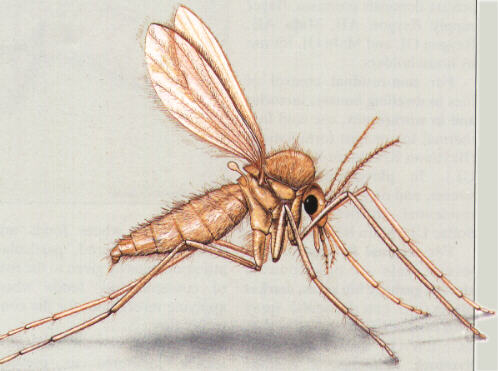
The dreaded Sandfly
According to Wikipedia, the Sandfly (or sand fly) is a colloquial name for any species or genus of flying, biting, bloodsucking Dipteran encountered in sandy areas, whether it is a beach or a residence built up on reclaimed land, so it seems I am living in Sandfly territory!
Both females and males will feed on vegetable fluids and nectar as found mostly near estuaries, lagoons, tidal flats and mangrove swamps. They breed in the wet soils in the tidal zones such as mangrove mud and sandy shores. They are a type of fly, and only a few groups within this family are known to suck blood. The female needs the blood to provide protein for her eggs.
I just have to include this; and I say it with feeling.
The Good Lord didn't create anything without good purpose.
But mosquitos come close.
Mozzies, Sandflies, Bugs and Bities, . . .
We have plenty of these in the warm sandy beach towns in Australia, however, these robust insects with mouths that pierce and suck so viciously, are found all over the world. They have maximum annoyance value, but are not known for transmitting any disease in Australia. Barmah Forest virus has been isolated from Culiocoides marks, but this is one of the good guys and rarely bite humans.
Thank heavens only three of the 270 species of Culiocoides found in Australasia tend to annoy humans. They prefer dull still days with high humidity when out hunting, as they are too small and light to cope with windy conditions
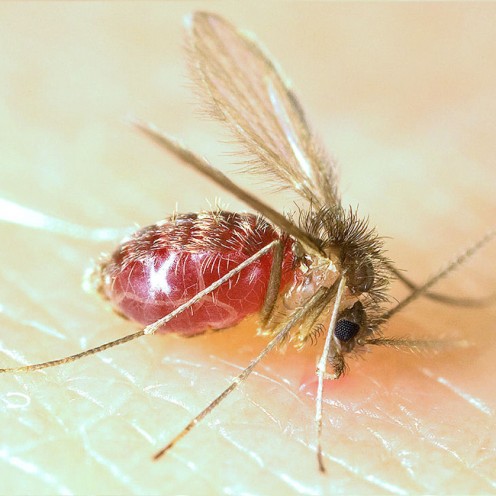
Dangerous Female
They are 1.5-4.0 mm long with stout short legs, and sit with their wings folded over the abdomen. Their feeding mechanism is fashioned so they can pierce the skin and drop anticoagulants which then tends to form a raised mark . Some people react to the bite straight away yet others do not feel it at all, but get very itchy later; sometimes, hours later. The sandfly’s saliva contains allergens that affect some people more than others. Some, like me, suffer acute bouts of itching for several days, despite attending to the spots with topical remedies. At times, the bites produce a serum-like leak from the bites. Locals tend to build up a resistance to the discomfort of the itchy bites and the irritation which can prompt one to scratch. This can lead to infected sores.
The midges tend to rest on screens, fences and vegetation watching and waiting to pounce on an unsuspecting human. Some species will blood feed on a wide range of animal hosts. The Females may attack humans in large numbers, biting on any areas of exposed skin, and often on the face, scalp and hands. They mostly hunt for blood during dawn and dusk, however, it is not unknown for them to be about at other times, especially if it is a dull, warm and moist day.
The egg batches contain between 30-100 eggs, and are laid on mud, decaying leaf litter, damp soil or other vegetative materials. The small eel-like larvae hatch in a few days; The whole life cycle takes 3-10 weeks, dependent on species and environmental conditions.
Common Sandflies in Australasia.
- Culiocoides spp (nr submaculatus) is found just about everywhere in Australasia,
- Culiocoides ornatus seem to prefer the north of Tin Can Bay in Queensland, and
- Culiocoides molestus tend to breed in canal estates. Mainly in the NE coast of Australia
- Cullicoides longior mainly in the NE coast of Australia
- Lasiohelia townsvillensis mainly in the NE coast of Australia
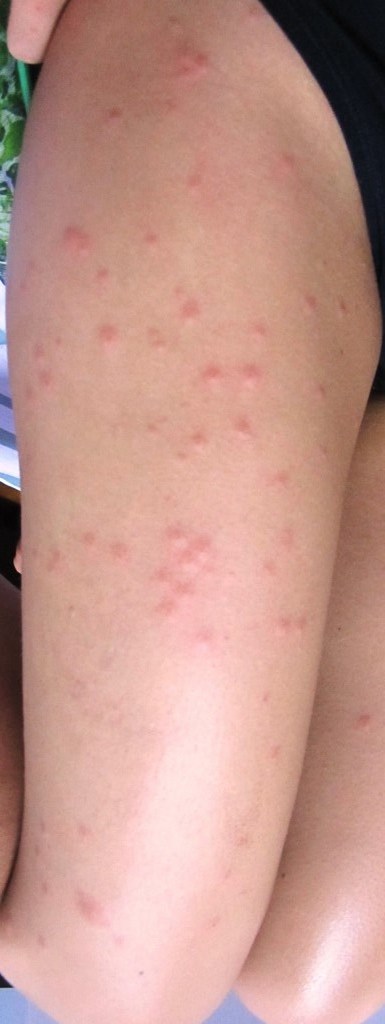
The Itch
I live in one of those warm sandy beach towns, so these biting Culiocoides are the bane of my life.
It is practically impossible to eradicate these pesky little biters from populated areas and they are, in fact, a valuable component of ecological environments. Any attempt to use pesticides could well cause significant harm.
The Australian demand for living in coastal areas has tempted some to ignore the age-old wisdom of keeping away from such areas and to develop land for housing that is close to the midge breeding sites. Buildings will need adequate screens to keep these midges out.
It is sensible to keep residential buildings at least 400-600 metres away from breeding sites, although some have been known to travel 3 kilometres in search of human blood.
If you become a blood-donor to one of these pesky critters, you can usually self-medicate with topical ointments. Some may have to add anti-histamines internally to heal properly and in a reasonably short time.
I have become very wary of places and times when I am the unwilling blood-donor to these sandflies. I also have my own formulaes of how to handle the bites, if and when they occur. I have also made note of other solutions provided by others, and I will list them for you shortly. I want to emphasise that I have not yet found any one method that works for everyone, any time, but you can pick and try if you need to.
My Own Methods for Relief and Cure.
- Hot showers, as hot as I can stand.
- White, plain vinegar . I find it is quick to stop the itch, but the effect does not last long.
- Ointments – I use an ointment that has 0.02 corticosteroids. The effect takes a half hour or so to take effect but lasts much longer, probably in the region of 5-6 hours. I use it after the vinegar splash to 'kill' the itch.
- I also keep a drip-spout plastic bottle in the kitchen with this mix, which I use often at times when Mosquitoes and Sandflies descend upon our little yard. In this small bottle, I put a mix of 1/3 White common vinegar, 1/3 Dettol, 1/3 water. It is a great splash & rub method of killing itches.
- Some friends who know how much I suffer from these blighters have suggested that those with supple skin, do not get bitten as much as those with thin taut skin as it is easier for the midges to pierce.
- For this reason, one friend keeps bare skin covered in a light body cream. She claims the slippery landing twarths the midge’s intentions.
As you can see there is no Cure-All for any of these pesky biters. You just have to arm yourself with as many armaments as possible, and then use judiciously.!
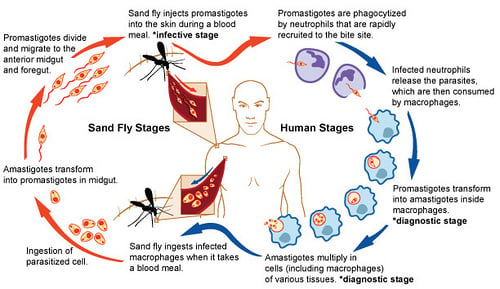
What others Recommend.
From Deb [A Local] “ Put a dob or two of eucalyptus oil (pure strength) on a tissue paper etc then scratch some layers of skin off the exact spot of the bite only (to get to the squirming parasite and be quick
before the oil starts drying), and hold the dob of very wet oil on the spot for 20 -30 seconds. This asphyxiates (chokes) the parasite to death and blocks its escape access after the top layer skin has been removed. The squirming will cease and itching will calm down. No bug can breathe around ‘menthol’.
Preventative measure -: Dab same oil on socks at ankles, bottom of trousers, around collars, cuffs, and spray overall body with the eucalyptus spray can (hold breath). Remember that bugs cannot breathe around eucalyptus. I hope this information brings you relief. “
James said “ April 30, 2013 at 4:20 pm
I am a greynomad and have been on many waterways fishing along the coast of qld since 2001. The first month I was given a receipe for mosquitos and sandflies. It is as follows==1 third baby oil==1 third methilated spirits==the other third equal quanities of dettol and any essential oil such as lavender or tea tree spray or wipe on unprotected areas===IT WORKS”.
byBOBINOZonNOVEMBER 30, 2011 ‘ ‘ But that was a long time ago. At the time I was being plagued by these things, so I took action. I settled on a two pronged attack.
First I started taking vitamin B; B6 specifically is supposed to be a deterrent. There is no scientific evidence for this, but for me it worked as I know it has for others. Interesting that you can get vitamin B from Vegemite, an Australian favourite, or Marmite, the slightly different (superior according to Mrs BobinOz) UK version.
Second, I bought a Yard Guard….
Deb Recommends. . .
DebOctober 15, 2015 at 12:55 am
Best remedy found for Sandflies after bitten – Put a dob or two of eucalyptus oil (pure strength) on a tissue / loo paper etc then scratch some layers of skin off the exact spot of the bite only (to get to the squirming parasite and be quick before the oil starts drying), and hold the dob of very wet oil on the spot for 20 -30 seconds. This asphyxiates (chokes) the parasite to death and blocks its escape access after the top layer skin has been removed. The squirming will cease and itching will calm down. No bug can breathe around ‘menthol’.
Preventative measure -: Dab same oil on socks at ankles, bottom of trousers, around collars, cuffs, and spray overall body with the eucalyptus spray can (hold breath).
For the home -: Hang used washed teabags on screen doors (particularly around each opening edge) and window screens, and periodically (hours) dob eucalyptus oil on each teabag.
Personal use repellent -: Use an empty roll-on deoderant bottle with a mixture of baby oil and eucalyptus oil to apply to the skin. Make the eucalyptus mixture as strong as tolerable.
Remember that bugs cannot breathe around eucalyptus. I hope this information brings you relief. All the
best …
Shauna April 28, 2014 at 10:21 am
Actually, sand flies are the main reservoir for the protozoan parasitic disease, Leishmaniasis. It can result in painful and nasty-looking skin ulcers at the site of a sand fly bite, and if left untreated can spread to your internal organs and cause death in 100% of cases within two years. Look it up. It’s pretty scary.
Cris April 30, 2013 at 4:43 pm
Hey its me again, The Bitten.
And yes I am still getting the bites, the antihistamines relieve the swelling but not the itch, and the cortesone cream relieves the itch not the swelling, Nothing stops these little buggars. and yet my mum lives with me and she never gets a bite.
I go to sleep covered in repellant, I spray the whole house till I choke on the stuff, and still I don’t hear one minor cough from the midges. I think they shower in the stuff. I am thinking of starting a new novel something like War of the Whorles, or Insect Worlds Collide. I have enough ‘extras’ for the movie version!
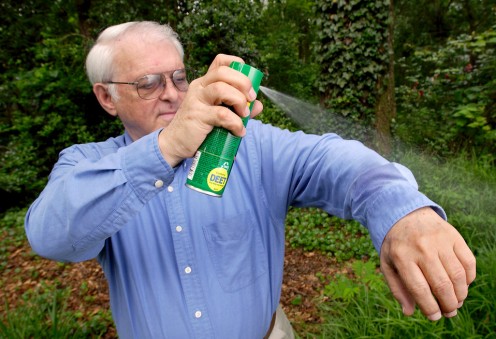
Sandfly Strategy In Brief
- Stay away from Sandfly haunts.
- Gardening first thing in the morning or at dusk is a good time to be attacked by sandflies.
- Wherever possible, wear long sleeves, long pants, socks and shoes, wherever there is danger of Sandflies.
- Spray repellent on exposed areas of the body, especially scalp, neck, hands and ankles. -DEET 15-20% type is effective, but some people do not like it on their skin.
- When indoors,you can use mosquito coils in the evening and turn on fans during the day as Sandflies do not like air currents.
- If you, like me, live in a sandfly area, then taking B1 every day is a good investment. It took me 2 years to feel the difference, but now I take the vitamin regularly, on top of any other vitamins I take, and know that any itches will not keep me in agony for 3-4 days, but a matter of hours.
Be aware that dawn and dusk are the high risk times. By taking cover for an hour at twilight you may avoid days of irritation.
The consumption of vitamin B has never been proven to help repel sand flies or mosquito’s but if you are enjoying a holiday in an infested region then your lifestyle may benefit from a few additional vitamins anyway.
DEET seems to be the chemical that continually raises its head as the best defence against fly type biting insects. It was developed in 1946 following the experience of American soldiers involved in jungle warfare and was again used in Vietnam.
It’s an entirely personal decision whether you want to cover your body in a chemical developed by the U.S. Military, nearly 70 years ago, with the scientific name N,N-Diethyl-meta-toluamide.
Update: Warren from the Broome Hospital sent us in an interesting note about their treatment for sandfly bites (Broome and the Pilbara and Kimberley regions in general have a widespread health issue with sand flies).
2. One of the best treatments that we use in Broome Hospital (where I work) is heat… usually from a very hot shower, as hot as you can take it for about 5 minutes will neutralise the toxin causing the histamine response. If you get it early, you may only need one application of heat, but if not a couple of times a day may be necessary!
Credits & Sources
By Westmead Hosp – Au - http://medent.usyd.edu.au/fact/bitmidge.htm#treat
http://www.jneurovirol.com/o_pdf/9(6)/577-583.pdf
http://www.bobinoz.com/blog/8602/no-see-ums-those-pesky-biting-midges-are-back/
http://bie.ala.org.au/species/urn:lsid:biodiversity.org.au:afd.taxon:2213682b-1e76-46af-be88-e6844c5a1c3b#tab_names
https://en.wikipedia.org/wiki/Lutzomyia
https://commons.wikimedia.org/wiki/File:Indonesian_sandfly_bites_on_leg.jpg
http://G:/Spray For Mozzies.jpg
http://www.outbackcrossing.com.au/Information/Sand_Fly_Bites_and_Prevention.shtml
© 2016 MarieLB







